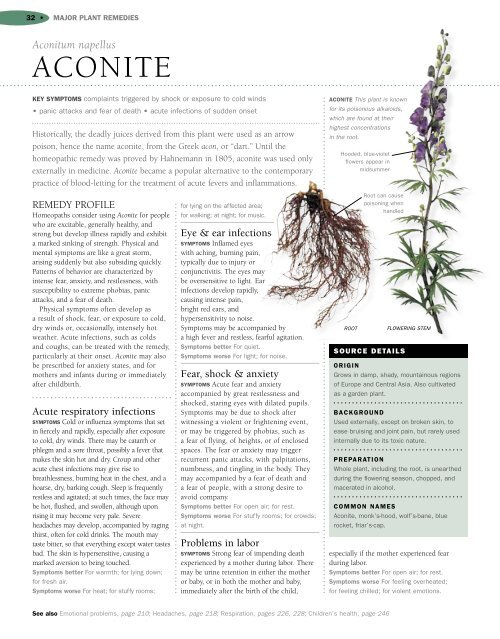Encyclopedia of Homeopathy
Encyclopedia of Homeopathy
Encyclopedia of Homeopathy
Create successful ePaper yourself
Turn your PDF publications into a flip-book with our unique Google optimized e-Paper software.
32 •MAJOR PLANT REMEDIESAconitum napellusACONITEKEY SYMPTOMS complaints triggered by shock or exposure to cold winds• panic attacks and fear <strong>of</strong> death • acute infections <strong>of</strong> sudden onsetHistorically, the deadly juices derived from this plant were used as an arrowpoison, hence the name aconite, from the Greek acon, or “dart.” Until thehomeopathic remedy was proved by Hahnemann in 1805, aconite was used onlyexternally in medicine. Aconite became a popular alternative to the contemporarypractice <strong>of</strong> blood-letting for the treatment <strong>of</strong> acute fevers and inflammations.REMEDY PROFILEHomeopaths consider using Aconite for peoplewho are excitable, generally healthy, andstrong but develop illness rapidly and exhibita marked sinking <strong>of</strong> strength. Physical andmental symptoms are like a great storm,arising suddenly but also subsiding quickly.Patterns <strong>of</strong> behavior are characterized byintense fear, anxiety, and restlessness, withsusceptibility to extreme phobias, panicattacks, and a fear <strong>of</strong> death.Physical symptoms <strong>of</strong>ten develop asa result <strong>of</strong> shock, fear, or exposure to cold,dry winds or, occasionally, intensely hotweather. Acute infections, such as coldsand coughs, can be treated with the remedy,particularly at their onset. Aconite may alsobe prescribed for anxiety states, and formothers and infants during or immediatelyafter childbirth.Acute respiratory infectionsSYMPTOMS Cold or influenza symptoms that setin fiercely and rapidly, especially after exposureto cold, dry winds. There may be catarrh orphlegm and a sore throat, possibly a fever thatmakes the skin hot and dry. Croup and otheracute chest infections may give rise tobreathlessness, burning heat in the chest, and ahoarse, dry, barking cough. Sleep is frequentlyrestless and agitated; at such times, the face maybe hot, flushed, and swollen, although uponrising it may become very pale. Severeheadaches may develop, accompanied by ragingthirst, <strong>of</strong>ten for cold drinks. The mouth maytaste bitter, so that everything except water tastesbad. The skin is hypersensitive, causing amarked aversion to being touched.Symptoms better For warmth; for lying down;for fresh air.Symptoms worse For heat; for stuffy rooms;for lying on the affected area;for walking; at night; for music.Eye & ear infectionsSYMPTOMS Inflamed eyeswith aching, burning pain,typically due to injury orconjunctivitis. The eyes maybe oversensitive to light. Earinfections develop rapidly,causing intense pain,bright red ears, andhypersensitivity to noise.Symptoms may be accompanied bya high fever and restless, fearful agitation.Symptoms better For quiet.Symptoms worse For light; for noise.Fear, shock & anxietySYMPTOMS Acute fear and anxietyaccompanied by great restlessness andshocked, staring eyes with dilated pupils.Symptoms may be due to shock afterwitnessing a violent or frightening event,or may be triggered by phobias, such asa fear <strong>of</strong> flying, <strong>of</strong> heights, or <strong>of</strong> enclosedspaces. The fear or anxiety may triggerrecurrent panic attacks, with palpitations,numbness, and tingling in the body. Theymay accompanied by a fear <strong>of</strong> death anda fear <strong>of</strong> people, with a strong desire toavoid company.Symptoms better For open air; for rest.Symptoms worse For stuffy rooms; for crowds;at night.Problems in laborSYMPTOMS Strong fear <strong>of</strong> impending deathexperienced by a mother during labor. Theremay be urine retention in either the motheror baby, or in both the mother and baby,immediately after the birth <strong>of</strong> the child,ACONITE This plant is knownfor its poisonous alkaloids,which are found at theirhighest concentrationsin the root.Hooded, blue-violetflowers appear inmidsummerROOTRoot can causepoisoning whenhandledSOURCE DETAILSFLOWERING STEMORIGINGrows in damp, shady, mountainous regions<strong>of</strong> Europe and Central Asia. Also cultivatedas a garden plant.BACKGROUNDUsed externally, except on broken skin, toease bruising and joint pain, but rarely usedinternally due to its toxic nature.PREPARATIONWhole plant, including the root, is unearthedduring the flowering season, chopped, andmacerated in alcohol.COMMON NAMESAconite, monk’s-hood, wolf’s-bane, bluerocket, friar’s-cap.especially if the mother experienced fearduring labor.Symptoms better For open air; for rest.Symptoms worse For feeling overheated;for feeling chilled; for violent emotions.See also Emotional problems, page 210; Headaches, page 218; Respiration, pages 226, 228; Children’s health, page 246
















